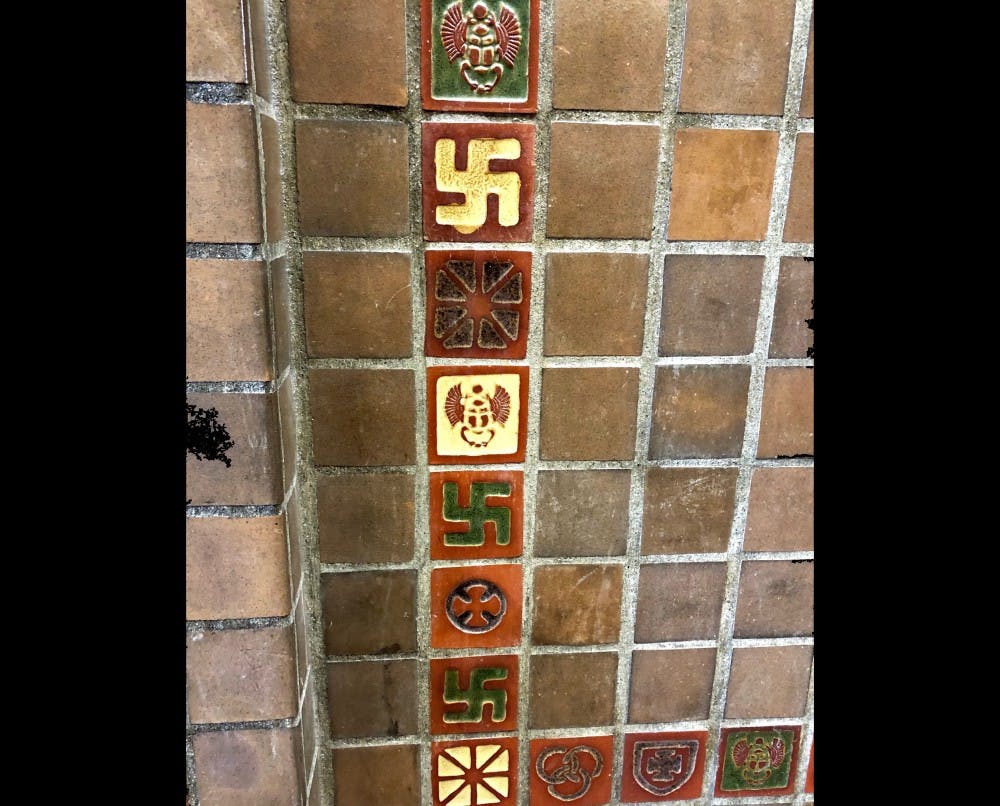For over 100 years, people entering the IU Intramural Center have been met with swastikas.
The swastikas were part of a display including other icons from across different cultures. For years, they drew controversy. But in the beginning of July, IU started to remove the tiles containing swastikas from the collection and sand down the images.
IU spokesperson Amanda Roach said in a statement to the Indiana Daily Student the tiles have been brought up to administration every year, but a decision was made to remove the tiles this year.
The tiles will be sanded over and altered to remove the swastikas. Work on the tiles is expected to be finished by early fall. The project is expected to cost around $400,000, according to the Bloomington Herald-Times.
It’s a decision that has drawn praise and criticism.
Professor Charles Beeker is the director of the IU Center for Underwater Science through the School of Public Health. He said while he agrees the symbol has been used inappropriately, he thinks the swastika tiles need to be considered under the context in which they were installed.
“It was meant to talk about wellness,” Beeker said. “It was meant to talk about the symbols that would be appropriate for a fieldhouse and the athletics and the events and now the School of Public Health.”
He said he wished the university would use the symbols as a learning opportunity instead of removing pieces of a historic IU building.
“It’s something that we want to teach about and talk about but not necessarily cover up and hide just to avoid controversy over something that is by no means intended to indicate any association with the atrocities that occurred later,” Beeker said.
The removal is the latest incident of the university addressing controversial campus landmarks. In 2017, the Office of the Provost announced classes would no longer take place in Woodburn Hall 100, a lecture hall which contained a mural panel depicting a KKK rally. Trustee Ora Wildermuth’s name was taken off the Intramural Center in 2018 due to his segregationist beliefs.
The tile display was created in 1917 when the oldest section of the Intramural Center, the Men’s Gymnasium, was built. Signs around the Intramural Center explained why the swastikas were included on the tiles.
The term swastika originated from Sanskrit, according to the United States Holocaust Memorial Museum website. For thousands of years, the symbol was used in Hinduism, Buddhism and Jainism. The symbol also appeared in pre-Christian European artifacts. Western culture at the beginning of the 20th century became fascinated with the swastika as a good luck symbol.
At the same time, an increasingly popular notion of a mythical ancient race called the Aryans began to take hold in Germany. When 19th century German archaeologist Heinrich Schliemann discovered swastikas in an ancient Turkish city that matched those found in Germany, it seemed like proof to many Aryans were real and had existed all around the world, according to Smithsonian Magazine.
Following World War I, the swastika was adopted by a number of far-right nationalist groups, including the Nazi party. Despite the use of swastikas now being synonymous with Nazism in western cultures, IU kept the tiles as a part of the Intramural Center because they were installed before Nazis adopted the symbol.
Even though the swastika tiles at the Intramural Center were installed before Nazi usage, some feel the positive intention behind their creation does not defend the effect of seeing the symbol.
IU Hillel Rabbi Sue Silberberg said she had received complaints about the swastikas for years.
“It has such a strong negative impact on people who see it that I think it’s almost like giving Hitler a victory all over again,” Silberberg said.
Silberberg said while she understands why the university did not remove the swastikas, she is glad that they are gone.
“I understood why they didn’t remove them, but I’m really glad they are now,” she said.




